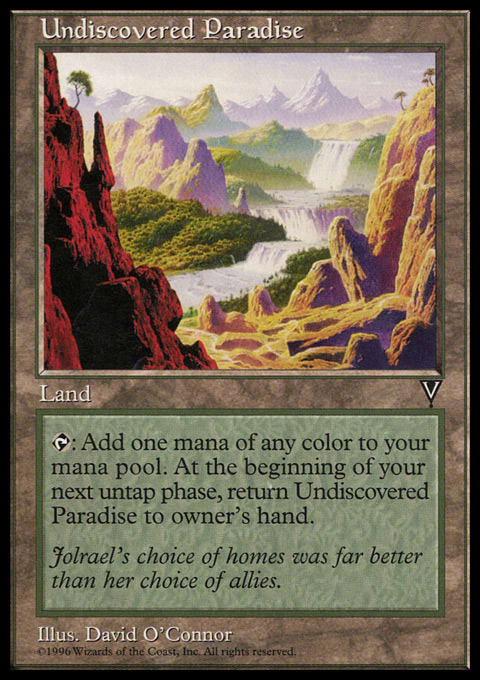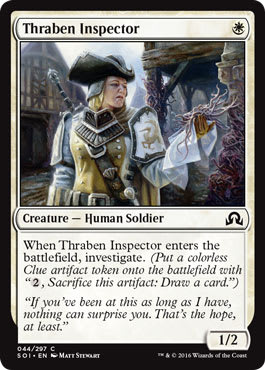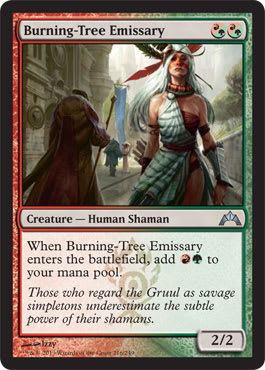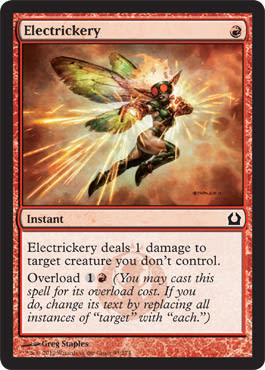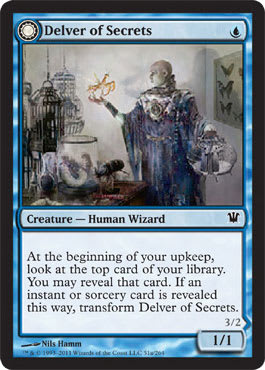There’s been a lot of hubbub recently on /r/Pauper about the nature of metagame, the decks at the top of the heap, and what it means for the format in general. As someone who has been following the Pauper metagame for years, I feel uniquely qualified to talk about this subject. Most of my articles here have a bend toward a wider audience, but this one is aimed more at die-hard Pauper players. With that out of mind, let’s dive in.
The Nature of the Metagame
Straight away I feel that this is something that needs to be addressed. In any competitive format, a best deck (or suite of best decks) will emerge. Anyone who has watched Standard over the past few years knows how hard Wizards has worked to try and keep it a dynamic experience — that is one where the best deck might change from week to week and tournament to tournament. Eternal and non-rotating formats are not nearly as dynamic due to a combination of well established archetypes and massive cardpools. The cream rises to the top and the chaff sinks.
In my opinion, this is the largest cognitive dissonance between newcomers and entrenched players. Those who have played the format for any stretch of time come to understand the landscape of Pauper. A lot of people just discovering the format see it as unclaimed territory and try to stake their claim. These players can often be crushed by tried and true decks and get disillusioned.
It is on us — the established Pauper players — to be truthful about the format. The myth of the “brewer’s paradise” runs rampant. Pauper may have untapped space for deck discovery but it is far from the Wild West. Instead there are well established parameters in which you should attempt to construct a competitive deck. If you take a hypothetical X-axis, with the Origin being “Wide Open” and the End Point being “Solved”, we are firmly on the right hand side of the midpoint.
The Banned List and New Cards
Moving off the hypothesis that Pauper is a format trending toward being solved, there are two methods to set it back toward the Origin. The first is the release of new cards, a regular occurrence. Now, before people clamor that Pauper just doesn’t get enough cards or that New World Order is holding the format back, I’m going to just plain old disagree with you.
First, the recent releases have had a bounty for Pauper. Amonkhet and Hour of Devastation have contributed nearly a dozen cards that see regular play in Challenges and Leagues (with some more on the fringes). While Kaladesh block was lackluster, Shadows over Innistrad gave us Thraben Inspector, a creature that helped to push quite a few decks towards a higher power level.
Pauper also gets access to non-Standard releases. Various Masters sets and Conspiracy cards have infiltrated the format and have helped to define it for the past year. Imagine Pauper without Augur of Bolas, Burning-Tree Emissary, Dinrova Horror, and Palace Sentinels and it looks dramatically different. Take away Ash Barrens and everything changes. New cards have a bigger impact than people think — they become ubiquitous so quickly it is hard to remember a time Before.
Of course there is also the Banned List. A tool used sparingly, this removes a card entirely from the metagame. Thus far it has been used on cards that prove untenable for a balanced competitive environment and I do not see this changing. I also do not see any cards currently that are fast tracked to be excised.
Netdecking and Pillars
It’s good. It’s really good. In fact, if you’re just getting into Pauper you should be netdecking more — not less. The top tier of decks are there for a reason and learning what makes them tick — all of them — will help you to understand different weaknesses to exploit and crevices in which a new deck can find a home.
Pauper has different decks acting as limiting factors. These are not necessarily the best decks but rather the best at what they do (and yes, they happen to coincide with being some of the better options in the format). These pillars, for the most part, are based around powerful interactions and cards. With that in mind, here is my current take on the lay of the land.
Stompy is the baseline deck in the format. It may not be best, but it does very well in a variety of metagames. That is because it is both a Rancor deck and a Burning-Tree Emissary deck. In moments that reward going wide it can do that just as easily as it can go tall. It is this built in adaptability that has allowed it to have an absolutely fantastic season thus far. In my opinion if you do not have at least a coin-flip matchup with Stompy, you should hang up your deck in the current metagame.
Izzet Delver is another important limiting factor. It is the deck best suited to take advantage of Blue’s powerful card filtering spells while also shoring up deficiencies in the mono-Blue version in adding cheap Red removal. After dominating Amonkhet season Challenges, it has taken a step back (but still has two wins and seven Top 8 appearances). Currently Black removal seems better positioned than Red removal (this is part of Pauper’s dynamism) and as such the deck’s strength is now mitigated (I wrote about the nature of removal in Pauper here).
Affinity remains the clock of the format — that is the deck you have to be faster than to stand a chance. Despite being absolutely busted, Affinity is kept in check by a number of factors. First is that it often dies to its own draws. It runs a bare minimum of lands and can often draw their artifacts in the wrong order, stranding solid threats in hand. Second is the fact it relies so heavily on artifacts — the single most vulnerable card type in Pauper thanks to Gorilla Shaman, Natural State, Ancient Grudge, and so many others. Yet the power of Galvanic Blast and Fling + Atog is a pull worth the risk.
The various Tron decks are the best endgame decks in Pauper. They are well situated to make use of their over abundance of mana and convert it into a win condition. Yet, despite the obvious strength, a best version of Tron has yet to emerge. The most common — Dinrova Tron — underperforms compared to other top decks. If anything, this is because Tron decks as a whole have started to skimp on interactive pieces in hopes of racing to an end game. The deck also tends to choke on colored mana sources forcing it to run slightly worse cards than normal to accommodate its mana base. On top of this Tron decks requires certain concessions to making specific colors of mana which in turn eats up slots that could be better spent on actual spells.
Boros Monarch may seem like an interesting deck to round out this list but it consistently overperforms. The Monarch is another powerful option in Pauper and the ability to generate an extra card per turn, free of charge, should not be underestimated. The Pauper version of Phyrexian Arena has helped to put traditional midrange back on the map. Dimir Flicker also falls into this camp with Ghostly Flicker + Mnemonic Wall acting as a Treasure Trove rather than an Arena, but the mana cost associated with running the combo makes it far less efficient than a Palace Sentinels package.
The Current Way of Things

* Indicates a Top 8 finish; ^ Indicates a challenge win
These are the Top 25 decks in the Hour of Devastation challenge season as of September 9, 2017. This list includes every Top 8 deck and every deck that has won a Challenge. It is sorted by Win+ order — a metric that measures how much better a deck has done than the deck to finish in 32nd place. When Win+ is greater than volume, that means a deck is over performing with regards to its frequency in the Top 32.
If you’ve been paying attention the list should make sense — Stompy sits on top with Affinity and Izzet Delver not far behind with everything else another notch below. What this list does not tell us, however, is how the decks matchup against each other, just against the field in general. It does not tell us what is the best deck in any archetype, just what has performed up to this point.
During the first part of Amonkhet season, Stompy underperformed and had a Win+ lower than its volume for the entire season. Izzet Blitz overperformed early before tailing off entirely. Now Stompy is the best performing deck while Izzet Blitz is only just coming back from a six week hiatus between Top 8s with strong back-to-back showings.
While some decks consistently do well there is no One True Deck in Pauper. No one build is going to defeat all comers and upset the entire metagame. Some decks like Stompy and Izzet Delver are better suited for wide open metagames but that does not make them best. If anything, it makes them relatively easy targets.
Understanding Cycles
So how do you attempt to play the metagame? First you have to accept that there is no “best deck” in the format; only that there is a best deck for a given tournament. You have to make your best educated guess given the information available. In my opinion, the best way to do this is by understanding the removal seeing play.
Let’s get this out of the way: often you can go wide without any fear of repercussion. While Electrickery and Evincar's Justice both see play, neither are slam dunks that completely invalidate swarm strategies. Consider this the first edge for Pauper deck-building: it is hard to punish going wide.
So back to the subject at hand — removal. If we accept the baseline removal spell as Lightning Bolt then we can start building out from that. Lightning Bolt can do a number of things better than other kill spells — namely it hits almost every small threat and will often trade up on mana. We have been in a Lightning Bolt world for the better part of two months and only now are starting to shift. In Lightning Bolt formats, the goal is to present multiple threats while also making them moderately resilient to the spell. I’m not saying you should run Galina's Knight and call it a day, but being able to mitigate it with Hunger of the Howlpack is pretty good.
When Red removal fails it is usually because decks like Izzet Blitz and Hexproof are ascendant. These decks thrive in metagames that under prioritize Chainer's Edict. Edict is terrible at hitting a specific creature. However it is better in a “destroy all monsters” strategy where it can double up with Black’s copious kill spells to help constrain an opponent’s offense. When decks shift back to a true go wide, then Red spells are better since they are on balance cheaper and can operate at a solid defensive speed compared to certain offenses.
Finally there’s White removal which straddles the line. Journey to Nowhere is never the best removal spell in the format but it often hits a nice middle spot. Usually White removal will act as a supplement to either Black or Red, or rounds out a decklist if it wants to be able to stop a few key threats. When the format shifts to places where Gurmag Angler reigns supreme and little else hits the battlefield, White excels.
That was a crash course in lesson two: watch the removal and act against what is coming, not what has been. Sometimes this means rendering their removal useless and sometimes it means being able to outlast it. Sometimes it just means being faster than their answers.
So, using these example we can examine the recent surge in Hexproof and Izzet Blitz. These decks are soft to Chainer's Edict which has been largely absent at the top of the format. Of course looking at the September 3rd Challenge we see a Chainer's Edict deck in 2nd, 9th, and 16th. That tells me that Edict decks are ascending and running one of these two “all in” strategies next week could be a mistake. However, if you ran a deck like Red Deck Wins, which laughs at Chainer's Edict, you would be well positioned.
Lessons Learned
That is where it comes full circle. You start by understanding the answers in Pauper. Why the answers? Because they are far more efficient than the threats. Yet the threats still matter. When trying to select the way you are going to win the game you want to make sure it has great odds of surviving. This is, in part, what makes Gurmag Angler and Delver of Secrets so strong. Angler dodges a lot of cheap removal and can come down quickly. Delver, on the other hand, can often eat a removal spell but does so after applying a ton of pressure. The fact it often comes with Spellstutter Sprite backup does not hurt its cause either. Picking a resilient win condition is part of reading the metagame and picking the right closer. Lesson three, therefore, can be summarized as know how you are going to win.
Too often I see Pauper decks skimp on win conditions or try to compact them into as few slots as possible. There is something attractive in running the ol’ Mistveil Plains mill you plan or trying to emulate CounterPost decks of old. But Pauper is none of these formats. Once you slim down your win package too much you run into real danger of not being able to close out games, especially against builds that are basically nothing but win conditions. Not only do you have to win, but you have to do it before they kill you.
One thing I feel could be better explored in Pauper is building a mana base. Some decks are built to maximize on greed and are packed densely with threats but skimp on lands. Other decks run too many lands that enter the battlefield tapped while still others act as if we are a format full of true dual lands. All of these are a disservice. Make sure your mana works. And stop asking for better lands — the mana is the best it has been in the entire history of the format. Part of Pauper is learning how to operate within the constraints of what we have and the vast majority of our lands are actively good.
The last lesson I want to talk about today may be the most important. Don’t be afraid to switch decks. A lot of times I see people play the same deck over and over, regardless of result. One only needs to look at the Challenge results to see the same list next to the same player time and time again, regardless of result. This goes back to the fallacy of the “One True Deck” — sometimes your pet deck just isn’t well positioned. It’s okay, I promise. Put it down and pick up one that is better for a given event. I understand that some people only have their one deck and that’s fine — but then you forfeit your right to complain if the tournament was hostile to your lack of preparation.
I try a lot of decks. My folder is littered with strategies that were successful at one point but have fallen on hard times. I do not like it when my favorite deck is rendered invalid by shifts in the metagame but that’s when I go back to the well and try something that is a step ahead, not half a step behind.
Wrapping Up
So that’s where I’m at today. Pauper is not a Brewer’s Paradise and there is no One True Deck. The metagame is not fluid but it is not made of tar. Know how you want to handle the threats coming at you before you decide how you are going to attack your opponent. And, for the love of all that is good in the world, build a solid mana base.













